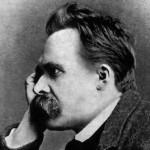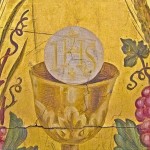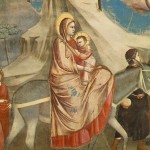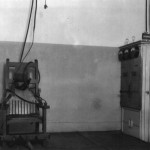
The Holy Spirit made unexpected feminine appearances in ancient Hebrew traditions.
“I have told you this while I am with you.
The Advocate, the Holy Spirit whom the Father will send in my name,
will teach you everything
and remind you of all that I told you.”
–John 14:26=========
“My mother the Holy Spirit took me by one of my hairs and carried me to Mount Tabor.”
–Origen, quoting an agrapha in his Commentary on the Gospel of John
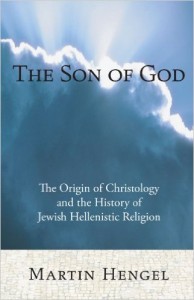 Martin Hengel’s little exegetical classical, The Son of God: The Origin of Christology and the History of Jewish-Hellenistic Religion, raises one of the most pressing questions in historical theology is explaining how the Christian dogmatic formulations concerning the divinity of Christ came together so quickly:
Martin Hengel’s little exegetical classical, The Son of God: The Origin of Christology and the History of Jewish-Hellenistic Religion, raises one of the most pressing questions in historical theology is explaining how the Christian dogmatic formulations concerning the divinity of Christ came together so quickly:
At the feast of the Passover in the year 30, in Jerusalem, a Galilean Jew was nailed to the cross for claiming to be Messiah. About 25 years later, the former Pharisee Paul quotes a hymn about this crucified man in a letter… The discrepancy between the shameful death of a Jewish state criminal and the confession that depicts this execute man as a pre-existent divine figure who become man and humbles himself to a slave’s death (Phil 2:6-8) is, as far as I can see, without analogy in the ancient world. It also illuminates the riddle of the origins of the christology of the early church.
Hengel explains this incredibly rapid development in the understanding of who Jesus was by the presence of intermediary figures in Old Testament theology. Like John the Baptist they prepared the way.
Elaborating the person of the Holy Spirit (later the Trinity) seems to carry an equal, if not greater, conceptual load than elaborating the divinity of Jesus. However, the teaching on the Holy Spirit also developed quite quickly.
This is because, according to Margaret Barker, in her book Great High Priest: The Temple Roots of Christian Liturgy, there are also Old Testament precedents for it, especially in the Wisdom Literature, but also in older unwritten Hebrew traditions:
There is a possibility that there has been here, too, a tendency to prejudge issues as to what could and could not have been ‘original’ to Christianity [emphasis mine, AR]. The Holy Spirit is described in this Gospel as Jesus’ mother who came to him at his baptism and said that she had been waiting for him, her first born, who would reign for ever. In him she had at last found her ‘rest’. There had been a division of opinion as to where Wisdom had found this ‘rest’ in the past; Ben Sira had described how Wisdom, after her long search, found her rest in Israel (Ben Sira- 24.7), but the tradition of the apocalyptists was very different. They said that Wisdom had found no place in Israel and had taken her place again among the angels (1 En. 42). The tradition of Wisdom’s exile was perpetuated in the Gnostic writings, and a Gospel that declared that Wisdom had finally found her rest in Jesus would have been the link between the ancient traditions of Israel and the later Gnostic writings. In the Gospel of the Hebrews, Jesus described how his mother lifted him up by the hair and carried him to Mount Tabor. To those who read only the Synoptic Gospels, these seem fantastic statements; but the belief that the Holy Spirit was both feminine, and, as Wisdom, the mother of the Messiah, was both ancient and widely attested. She appears throughout Gnostic literature as Sophia, and the setting of these texts places both her and the tradition firmly within that of ancient Israel. Further, one only has to read Ezekiel’s account of his heavenly journey to Jerusalem to see that the Spirit was described there, too, as having carried the prophet by his hair (Ezek. 8.3). It was doubtless the conventional way for such an experience of rapture to be described, but the very fact that it was conventional should warn against assuming that such descriptions could not have been part of the original tradition about Jesus. The real question raised by such material is not: Where did it come from and why? but: Why did it disappear from the public form of the tradition? Clement, who knew a secret tradition at the end of the second century CE, knew all this material and used it freely.
Now you know why the Holy Spirit fired the Hebrew imaginations of the Early Christians. The emphasis upon the feminine aspect of the Holy Spirit (we must always remember the gendering is used analogically!) seems to have mostly fallen out of most Christian traditions. It continues to be emphasized by the Syriac Christian traditions [see especially: After the Spirit] that are being decimated after America’s Gulf Wars. Pray for them on this Pentecost. May your prayers be heard.
It seems appropriate to sign off with my favorite rock song on the Holy Spirit from the album Achtung Baby:
For more surprises from the Holy Spirit see: What Are the 7 Essential Poems for Pentecost? +Pantheon Surprise
Stay in touch! Like Cosmos the in Lost on Facebook:
Please consider making a donation to this blog through the donation button on the upper right side of its homepage.


